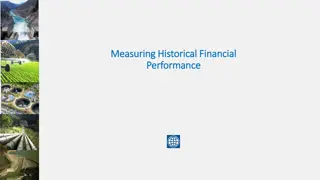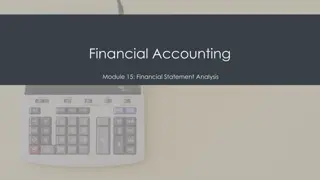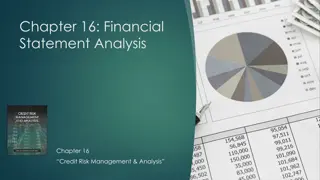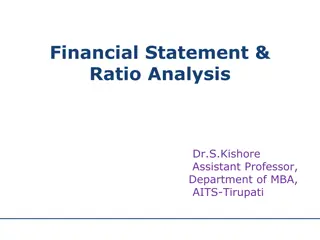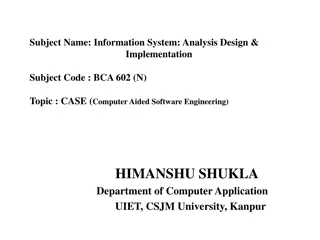
Financial Statement Analysis Tools and Techniques Explained
Learn about the tools and techniques used in financial statement analysis, including comparative statements and balance sheets. Understand how to interpret financial data to assess a company's performance and financial health effectively.
Download Presentation

Please find below an Image/Link to download the presentation.
The content on the website is provided AS IS for your information and personal use only. It may not be sold, licensed, or shared on other websites without obtaining consent from the author. If you encounter any issues during the download, it is possible that the publisher has removed the file from their server.
You are allowed to download the files provided on this website for personal or commercial use, subject to the condition that they are used lawfully. All files are the property of their respective owners.
The content on the website is provided AS IS for your information and personal use only. It may not be sold, licensed, or shared on other websites without obtaining consent from the author.
E N D
Presentation Transcript
Tools of Financial Statement Analysis Presented by Dr. B. N. Shinde Assistant Professor Department of Commerce Deogiri College, Aurangabad
Tools of Financial Statement Analysis Financial statements are prepared to have complete information liabilities, equity, reserves, expenses and profit and loss of an enterprise. To analyze & interpret the financial statements, commonly used tools are comparative statements, common size statements etc. regarding assets,
Conti.. 1. Comparative Statements Also known as horizontal analysis, are financial statements showing financial position & profitability at different periods of time. These statements give the enterprise financial position of two or more periods. Comparison of financial statements is possible only when same accounting principles are used in preparing these statements. an idea of
Conti.. a) Comparative Balance Sheet The progress of the company can be seen by observing the different assets and liabilities of the firm on different dates to make the comparison of balances from one date to another. To understand the comparative balance sheet, it must have two columns for the data of original balance sheets. A third column is used to show increases/decrease in figures. The fourth column gives percentages of increases or decreases. By comparing the balance sheets of different dates, one can observe the following aspects Current financial position and Liquidity position Long-term financial position Profitability of the concern
Continue.. Comparative Balance sheet is prepare to know change of Assets, Liabilities and capital of the business on two different dates. It contains column for 1. Absolute data for the previous year 2. Absolute data for the current year 3. Changes in the items of Balance sheet
Comparative Balance Sheet Particulars 2013 2014 Absolute change Percentage of Increase or decrease Fixed Assets 1000000 1200000 200000 +20% Current Assets 500000 400000 100000 -25%
Conti.. b) Comparative Income Statement: Traditionally known as trading and profit and loss A/c. Net sales, cost of goods sold, selling expenses, office expenses etc are important components of an income statement. To compare the profitability, particulars of profit & loss are compared with the corresponding figures of previous years individually. To analyze the profitability of the business, the changes in money value and percentage is determined.
Conti.. By comparing the profits of different dates, one can observe the following aspects: The increase/decrease in gross profit. The study of operational profits. The increase or decrease in net profit Study of the overall profitability of the business.
Comparative Income Statements Particular 2013 2014 Absolute change Percentage Increase or Decrease Net Sales 1000000 1200000 200000 +20% Cost of goods sold 400000 500000 100000 +25% Gross profit 600000 700000 100000 +16.67 Less: Operating 134000 183000 49000 +36.56% Operating Profit 421000 412000 (9000) (2.14) Add: Non-Operating Income 17000 22000 5000 32.35% Less : Non operating Exp. (12000) (22000) 10000 83.33% Net Profit 426000 412500 (13500) (3.17)
Conti. 2. Common Size Statements Common size statements are also known as Verticalanalysis . Financial statements, when read with absolute figures, can be misleading. Therefore, a vertical analysis of financial information is done by considering the percentage form. The balance sheet items are compared: to the total assets in terms of percentage by taking the total assets as 100. to the total liabilities in terms of percentage by taking the total liabilities as 100. Therefore the whole Balance Sheet is converted into percentage form. And such converted Balance Sheet is known as Common-Size Balance Sheet. Similarly profit & loss items are compared:
Conti. to the total incomes in terms of percentage by taking the total incomes as 100. to the total expenses in terms of percentage by taking the total expenses as 100. Therefore the whole Profit & loss account is converted into percentage form. And such converted profit & loss account is known as Common-Size Profit & Loss account. As the numbers are brought to a common base, the percentage can be easily compared with the results of corresponding percentages of the previous year or of some other firms.
Common Size Income Statement Particulars Amount Percentage (%) Sales 826000 Less: Sales Return 16200 Net Sales 810000 100 Less : Cost of Sales 491400 60.67 Gross Profit 318600 39.33 Less: Operating Exp. 243000 30 Net Operating profit 75600 9.33 Add: Non operating exp 8100 1 83700 10.33 Less: Non operating exp. 10800 1.33 72900 9 Less: Tax provision 36450 4.50 Net profit after tax 36450 4.50
Common Size Balance Sheet Particulars 2013 2014 Rs. Percentage Rs. Percentag e Assets Fixed Assests 120000 52.17 175000 51.47 Current Assets 110000 47.83 165000 48.53 Total Assets 230000 100 340000 100 Liabilities Fixed Liabilities 167500 72.82 265000 77.04 Current Liabilities 62500 27.18 75000 22.06 Total Liabilities 230000 100 340000 100
Conti.. 3. Trend Analysis Also known as the Pyramid Method. Studying the operational results and financial position over a series of years is trend analysis. Calculations of ratios of different items for various periods is done & then compared under this analysis. Whether the enterprise is trending upward or backward, the analysis of the ratios over a period of years is done. By observing this analysis, the sign of good or poor management is detected.
Comparative B. S. ( Trend Analysis) Assets 2012 2013 2014 2015 2012 2013 2014 2015 Cash 10000 15000 20000 5000 100 150 200 50 Sundry Debots 40000 60000 80000 100000 100 150 200 250 Stock in trade 100000 140000 175000 200000 100 140 175 200
Continue. 4. Ratio Analysis Quantitative contained in a company s financial statements is ratio analysis. It describes the significant relationship which exists between various items of a balance sheet and a statement of profit and loss of a firm. 5. Cash Flow Analysis 6. Funds Flow Analysis analysis of information




